When it comes to any wilderness survival situation, there is one potential danger for which many preppers are not entirely prepared. I’m not talking about lawless bandits or some form of the plague; I’m talking about snakes. Venomous ones, with dripping fangs.
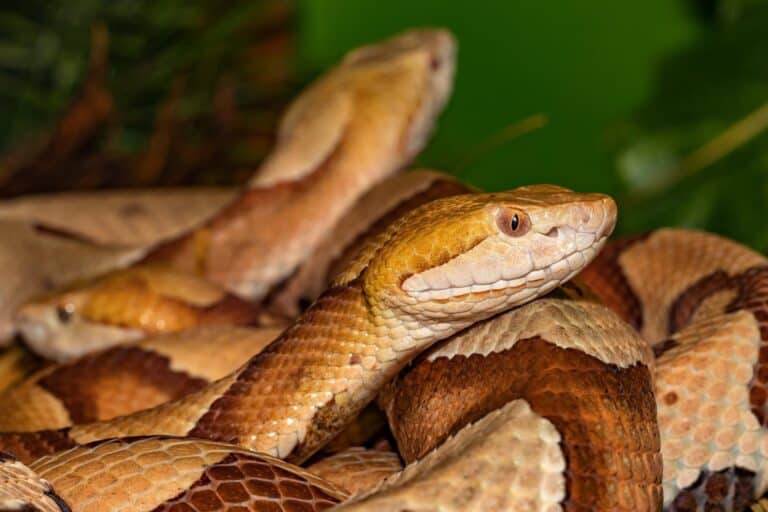
The last thing you want to happen after preparing to survive in the wilderness is getting bit by a snake and worse yet not knowing what to do.
Knowing your snakes is an incredibly important part of wilderness survival. Knowing the territory, habits, and behavior of the critters that can hurt you is always a boon, as it will help you be alert when conditions are right to encounter them.
Many snakes are perfectly harmless to people, but there are many that are venomous, and several that are so venomous there is a high chance you’ll die if bitten.
In this article, I will take you through some of the most dangerous snakes on the North American continent and then discuss snakebite response, first aid and just as importantly what you should not do if bitten. All of it might save your life!
Copperhead
- Latin Name: Agkistrodon contortrix
- Range: Predominantly eastern seaboard from New York to Florida, can be found as far west as West Texas, Oklahoma, and Nebraska.
A Copperhead is a modestly sized snake and on average will reach anywhere from 3 feet long to just a hair over 4 feet.
This snake is notable for its irregularly banded coloration, chunky appearance and excellent camouflage.
It also employs a unique strategy when startled or threatened: the snake will hold still, completely motionless and giving no other warning, only lashing out when intruder steps on it or draws way too close.
This means that you are highly likely to encounter and step on a Copperhead in areas of significant ground cover since you are probably not going to spot one until it’s too late.
Copperheads are not particularly aggressive, and are also known for delivering a bite that utilizes very little or even no venom at all, what is known as a “dry bite”.
A dry bite is often the initial strike when the snake is defending itself, but any subsequent bites are likely to mean full envenomation.
Luckily, copperheads have some of the weakest venom among all pit vipers, and even full charge bites are rarely fatal in humans. Antivenin is available but is rarely employed considering the side effects are often times worse than the bite itself.
Bite symptoms include tingling, swelling, throbbing and extreme pain especially near the bite site. This is often accompanied by significant nausea.
Muscle and bone tissue death is possible, especially on extremities such as the hands and feet. Despite its reputation as a minimally dangerous venomous snake, you must still seek prompt medical attention if you are ever bitten by a copperhead.
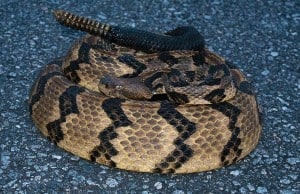
Timber Rattlesnake
- Latin name: Crotalus horridus
- Range: Northeastern U.S., typically encountered in dense woods.
The timber rattlesnake, commonly called the timber rattler, has a ferocious reputation as a highly dangerous venomous snake and famously graces the Gadsden flag.
Despite the myths surrounding the critter, it is still only the third most dangerous of the rattlesnakes encountered in North America.
This is no slight however, as the Timber Rattlesnake is one of the largest of its kind, and can easily grow beyond 5 feet.
One record-breaking specimen actually grew beyond 6 feet long. These are dense, muscular snakes that will easily tip the scales over 6 lbs., with the largest recorded weighing nearly 10 lbs.
The timber rattlesnake hunts its prey by striking from ambush, relying on its dusky spotted brown-to-nearly black scales to hide and wait for its prey to blunder by.
On defense, thankfully, the timber rattler is generally considered ambivalent to hesitant when it comes to striking at humans, and will often enact a defensive posture with its characteristic loud rattle or warning buzz that is typical of its species.
But when it does bite, buckle up! Like most rattlesnakes, the timber rattlesnake is infamous for delivering a lightning quick strike and injecting a massive payload of venom in one shot.
Of particular concern is the variable nature of the venom. Depending on the locale they inhabit, Timber rattlesnakes may exhibit variations in the type of venom that they produce.
Specimens found near the southern part of their range exhibit a deadly neurotoxic component to their venom, while ones found in the extreme Northern prong of their range feature a hemorrhagic component.
Perhaps most shocking of all is that ones living somewhere in the middle of their territory produce a lethal cocktail containing both permutations.
This is predominantly an academic concern however, since any timber rattler you encounter will be a large, fast snake with long fangs that will certainly deliver a massive dose of venom.
Any bite from a timber rattler is a life-threatening event and you must act at best speed if you want to survive.
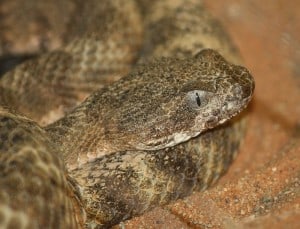
Tiger Rattlesnake
- Latin name: Crotalus tigris
- Range: Extreme southwest U.S. only (Arizona) into Northern Mexico.
The tiger rattlesnake is one of the smallest in the US, easily identified by its variably striped appearance, mottled coloration, proportionally small, shovel shaped head and dark stripes on its cheeks.
Averaging only 2 feet long and weighing right at a pound, this is one species of rattlesnake that some people would foolishly underestimate.
But be warned, this small and rare rattlesnake packs a terrible wallop: it is the third most venomous snake in the entire Western Hemisphere, and its venom is another multispectral toxin that makes it extremely difficult to treat.
The snakes are also notable for being unpredictably active during different seasons and changing weather, and while a terrestrial species have also been widely reported climbing brushes, scaling cliffs and even swimming.
Like most rattlesnakes they are fairly reluctant to strike, but are easily roused to anger when startled or threatened.
This is another snake that features a bite that can be deadly to the foolish: it does not produce or inject much venom compared to some of its cousins, but when it does bite it might not immediately result in pain or symptoms at first but is nonetheless.
Nonetheless, antivenin treatment in the immediate aftermath of the bite is essential to assure a good outcome.
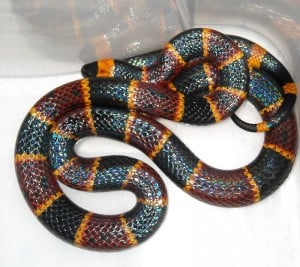
Eastern / Western Coral Snake
- Latin name: Micrurus fulvius/Micruroides euryxanthis
- Range: Range: American South, from Eastern seaboard to as far west as Arkansas and Texas.
The Coral Snakes of the United States are easily identified by their bright coloration, consisting of large black bands that are bordered by thin yellow bands before transitioning to large red bands.
This gave rise to the old outdoorsman jingle- “Red to Yellow, Kill a Fellow; Red to Black, Venom Lack” to help remind folks how to distinguish this dangerous, venomous snake from its non-venomous mimics, among them the Scarlet Kingsnake and the Milk Snake.
These snakes are of slight build, growing anywhere from 2 feet to just shy of 4 feet long, with smooth, narrow bodies and small blunt heads.
But you had better hope you memorize that rhyme up there and don’t get it wrong: coral snakes have some of the most ferociously lethal venom of any snakes on earth.
But lucky for us, there is a catch: these snakes have extremely small fangs and cannot inject a large dose in one strike, instead of having to rely on multiple, successive bites in a sort of chewing action to ensure full envenomation.
Also, luckily for humanity, the snakes are fairly rare to encounter and will run at the first sign of trouble so bites on humans remain seldom.
If a bite does occur and venom is injected, you’ll be facing a lethal toxin that paralyzes muscles necessary for respiration, meaning that if you do not get medical help quickly and artificial or assisted ventilation, you are probably toast.
More bad news: the only supplier of antivenin stopped making it some years back since bites are so rare and modern, synthetic antivenins are not forthcoming at press time.
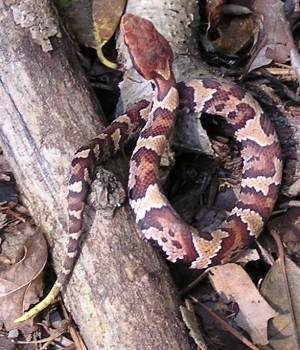
Cottonmouth
- Latin name: Agkistrodon piscivorus
- Range: Common all throughout the Southeastern U.S. through southern Midwest in or near all bodies of water.
A close relative of the copperhead, the cottonmouth, or water moccasin as it is commonly known, is a study in contrasts.
Where the copperhead is famed for its camouflage and infamous for remaining motionless when threatened, the cottonmouth displays more striking coloration inside and out.
When threatened, it will readily assume a strike-ready pose, hiss and then gape its mouth wide open, showing its fangs and the pale or dirty white interior of its mouth that lends it its name.
While not truly aggressive, it is significantly more aggressive than its cousin the Copperhead.
These snakes also run larger than copperheads, averaging longer than 3 feet in length and capable of growing up to 6 feet long, in addition to possessing a heavily muscular build.
Perhaps the snakes most famous characteristic is its affinity for water, be it fresh or saline.
Cottonmouths are powerful swimmers and have been observed in freshwater ponds, streams, rivers and even the ocean or saltwater estuaries. They’re also somewhat known for colonizing islands just offshore.
Seemingly “better” than its lesser Copperhead relative in every way, the Cottonmouth also possesses more potent cytotoxic venom that breaks down and dissolves proteins.
This can lead to shocking amounts of tissue death. Bites are comparatively frequent compared to other snakes, though deaths are rare.
The aftermath of a bite can often result in significant scarring and occasionally amputation, so don’t take these guys for granted just because you aren’t dealing with some scary rattlesnake.
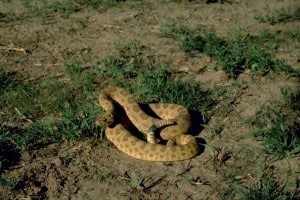
Prairie Rattlesnake
- Latin name: Crotalus viridis
- Range: Southern Ontario through U.S. Midwest and into northern Mexico.
AKA the Great Plains Rattler. A medium sized rattlesnake that averages about 3 and 1/2 feet in length. Coloration and patterning is highly variable, with example specimens found on the western end of its range lightly colored with brown contrast color.
Specimens located elsewhere maybe more uniformly colored with indistinct patterning. Commonly encountered among foothills, valleys, and on rocky outcroppings. Can occasionally be found having invaded the boroughs of smaller animals.
This is another rattler that is typically ground-bound, but is an able climber and is sometimes found up in trees or taller bushes
This snake is unique for packing a powerful and complex venom and dumps upwards of half of its supply in a single bite.
The venom then goes to work wiping out blood cells, attacking the nervous system and breaking down tissues along with causing searing, life-altering pain.
Though not particularly aggressive and known for being shy, like other rattlesnake species Prairie Rattlers are prone to assuming an S-shaped defensive posture when threatened and issuing a warning buzz with their tail.
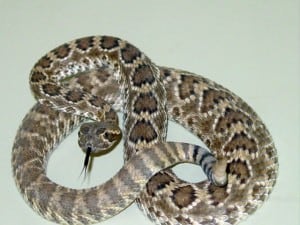
Mojave Rattlesnake
- Latin name: Crotalus scutulatus
- Range: Southeastern U.S., from California/Nevada all the way through central Mexico.
The Mojave Rattlesnake is not particularly intimidating in length or overall mass compared to some other rattlesnakes on this list, but under estimating it would probably be the last mistake you would ever make.
With an average length of less than 3 ½ feet it is on the small side but its venom still packs a tremendous wallop.
Found in a comparatively small range throughout the southeastern United States, this is another rattlesnake with a fair amount of variability in its coloration, including a greenish tint that has led to its other common name, the Mojave Green.
The snake’s reputation for aggressiveness is well-known among people in and near its habitat. Scientific inquiry and observation of the snakes in the wild ending captivity does not support this, but this rattler’s ferocious reputation remains all the same.
This rattlesnake is most notable for having a neurotoxic-hemotoxic venom that is a lethal double whammy for anybody bitten by it, and is near the very top of the list for rattlesnake lethality and is even counted among the very most venomous snakes in the entire world.
Even more insidious, the onset of symptoms and even serious pain can be quite delayed after a bite, sometimes lulling the doomed victims into thinking they got a dry bite, or one with very little venom injected, setting them up for an agonizing death once the venom progresses too far before they realize their mistake.
Symptoms of envenomation include visual aberrations, difficulty swallowing, and difficulty speaking. Significant reactions lead to substantial muscular weakness and total respiratory failure. Perhaps the only saving grace is that the correct antivenin for the snake is widely available.
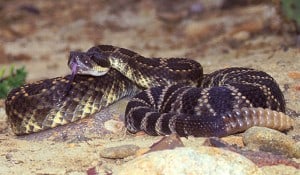
Black Diamond Rattlesnake
- Latin name: Crotalus helleri
- Range: Extreme southwestern California, U.S., into Baja California, Mexico.
Another rattlesnake of highly variable length and coloration, the Black Diamond Rattlesnake is a chunky reptile that measures anywhere from 2 feet to almost 5 feet in length, and has a pale brown base color that can range anywhere from gray to almost yellow, and features the characteristic, overlaid roughly diamond-shaped markings common to many rattlers.
The diamond shaped markings are, as a rule, surrounded by lighter colored scales.
Like all rattlesnakes, the Black Diamond Rattler is highly venomous, and its venom is similar in composition to the notorious Mojave toxin found and the Mojave Rattlesnake above.
A combination of hemotoxins and myotoxins will attack, degrade and destroy muscle tissue and nerve tissue with equal fervor, and bites from the snake, while rare, will easily be fatal without prompt treatment.
Also notable about this rare reptile is that a significantly higher dose of a specific antivenin is needed in order to successfully treat a bite compared to other species of pit viper found in North America.
This is definitely one snake you need to watch out for if you are traveling in Southern California!
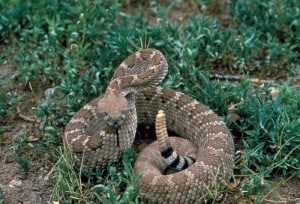
Western Diamondback Rattlesnake
- Latin name: Crotalus atrox
- Range: All throughout the American Southwest and much of Mexico.
The smaller cousin to the massive and mighty Eastern Diamondback, the Western Diamondback Rattlesnake is no less dangerous, and only just lags behind its more lethal relative in annual deaths from snakebite in the United States
It should be noted it is the current champion among killer snakes in Mexico.
Record-setting examples of this species tip the scales at a little over seven feet and will weigh around 15 pounds at that size, but are far more typically encountered anywhere any in the high 3- to low 5 foot range and will weigh around 10 lbs.
This is still a powerfully-built snake, but nowhere near the girth and length of the average Eastern Diamondback Rattlesnake.
The snakes are often regarded as the most aggressive of the rattlesnakes and since your chances of encountering them in their range are quite high and the fact that they prefer highly diverse habitation everywhere from rocky hills and mountains to swamps to sun-baked desert, you’ll need to be on your toes.
The snakes are known to rattle loudly and early when they feel threatened, but as always they are more than capable of striking without making a sound. Don’t believe the old wives’ tales that suggest these snakes must rattle before they can strike and inject venom.
The venom of the Western Diamondback Rattlesnake is principally hemotoxic in nature, but also contains cytotoxins and myotoxins, the combination of which results in a hideous array of deleterious effects, including severe muscle damage, blistering and tissue necrosis.
Systemic effects including nausea, abdominal pain, convulsions and loss of equilibrium. Primary cause of death resulting from a bite is often severe internal bleeding.
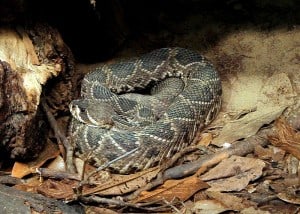
Eastern Diamondback Rattlesnake
- Latin name: Crotalus adamanteus
- Range: Found throughout the southeastern United States.
The largest of the American rattlesnakes, and one of the largest and heaviest venomous snakes in the world, the Eastern Diamondback has certainly earned its reputation as a magnificent and intimidating reptile.
Some of the largest specimens on record have closed in on 8 ft in length and weighed over 30 pounds.
The trademark warning rattle of this species is particularly well-developed and can be heard from a significant distance away, but one should not count on that to save you, as they may certainly strike without issuing the warning buzz.
They are known to inhabit pine forests, palmetto woods, marshes and swamps of all kinds, meaning they will be able to make use of their good camouflage.
The snakes are large and powerful, and currently hold the title and reputation as the most dangerous rattlesnake in North America.
While not particularly aggressive, the size of these snakes means that they have proportionally large fangs compared to their body weight, and can inject significant quantities of venom.
Studies reveal a 10 to 20% mortality rate from bites if left untreated, and their venom is both highly necrotic and responsible for significant internal hemorrhaging. Antivenins are effective but require massive doses with all the attendant secondary side effects that this entails.
If you should happen upon one of these large and impressive snakes in your travels, stay well away from them as they are just as likely to stand their ground and strike repeatedly as they are to retreat.
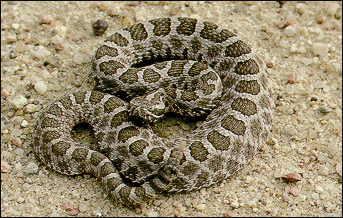
Massasauga
- Latin name: Sistrurus catenatus
- Range: Stretches from American Southwest northward and east, all the way through the northmost tip of Michigan.
The Massasauga is a small rattlesnake that rarely grows longer than 2 feet at most. Sometimes known as the Black Rattler for the large black spots that run down its spine flanked by rows of smaller black spots, this is one rattlesnake that may not have a particularly distinct pattern depending on its age.
The snake does not have a threatened conservation status, but it’s still rare to see compared to its larger cousins in the United States; it is shy and quick to avoid confrontation and in particular people.
The venom of the Massasauga is noteworthy for being principally cytotoxic in nature, and that means it will destroy tissue and preclude the body’s clotting process, severely disrupting blood flow. The typical cause of death and dismemberment from the snake is due to severe internal bleeding.
Also of note is that while deaths from bites are very rare, and even rarer with treatment, the specific antivenin for this snake is extremely scarce, and even scarcer if you’re away from a major treatment center.
Snake First Aid
If you are bitten by a snake, you need to take that bite very seriously even if the pain is not severe.
Unless you are absolutely certain of what snake bit you and you know without a doubt that it wasn’t a venomous snake, you must assume it was.
Some venomous snakes have slow-acting toxins in their venom that can creep up on you!
You have to seek treatment as quickly as possible when bitten by a snake. If you are close to civilization, then you will have a better chance of getting to a hospital and getting the anti-venom treatment you need quickly.
However, if you are in the bush or far from a hospital or other treatment facility, then you need to know what to do to give yourself the best chance of survival.
What Not to Do
First, I am going to take you through what you should not do when you are bitten by a venomous snake.
I am putting this section first because it is very important that you do not do these things and in a situation in which you may not be thinking clearly, you should avoid making these sometimes-fatal mistakes at all costs.
When bitten by a venomous snake:
- DO NOT make a tourniquet as this can cut off the blood supply to the limb, leading to gangrene and the possible amputation of the limb.
- DO NOT give a painkiller, particularly aspirin, as it can cause the blood to thin and the venom to spread through the body more quickly.
- DO NOT apply ice or a cold compress to the wound as research shows this does not deactivate the venom and can cause frostbite to the area of the wound.
- DO NOT try to suck out the venom as this puts the victim at risk further injury to the site of the bite; the person sucking by mouth risks the poison entering their system and bacteria from that person’s mouth can contaminate the wound.
- DO NOT cut the wound in an attempt to remove the venom as this causes increased damage and can cause infection of the wound.
- DO NOT use an electric device, such as a stun gun, on the wound as the use of electricity has been proven ineffective and potentially harmful through animal studies.
- DO NOT elevate the affected limb higher than the heart as this will cause the venom to reach the heart more quickly.
- DO NOT capture the snake for identification as this is dangerous and increases the potential for additional bites. Trust me, the docs don’t want it. It’s enough to remember what the snake looked like or take a picture of it, so you can tell those who will treat the snake bite.
- DO NOT give the victim alcohol or caffeine as this will speed up the spread of the venom throughout the body.
What You Should Do
Now that we have the don’ts out of the way, let’s talk about what you need to do when you or someone else gets bitten by a venomous snake.
First and foremost, stay calm and get away from the snake. Be absolutely sure you are out of the striking range of the snake so that it cannot inflict another bite.
The next thing you must do is summon medical help, if you can raise them and they can get to your location relatively quickly and easily.
If you are able to get to a phone or use your cell phone, then call 911 (or whatever your local emergency number is) and ensure that help is on its way. Ensure you have a plan for meeting the responders and guiding them to the victim’s location.
While you are waiting for help to arrive, do the following:
- Take off any tight clothing or jewelry in the area of the bite that can become too tight and cut off blood flow as the victim begins to swell.
- Remove the victim’s shoes if the bite was on the foot or leg so they won’t become too tight and cut off blood flow as the limb swells.
- Position victim in a way that ensures the bite is below the level of the heart. If the bite is too high the venom can reach the heart more easily.
- Keep still as much as possible to keep heart rate low; the more you move around the faster the venom will circulate through the body.
- If the victim must move to effect rescue they should move with minimal exertion.
- Clean the bite area with antiseptic, and dress the bite with a pressure bandage if the bite is on a limb to help stop any bleeding and keep swelling down.
- If the bite is on the trunk of the body, apply firm pressure to the wound to keep it from bleeding and keep swelling down.
- If you do not have any dressings for the wound, keep track of the swelling by tracing the area of swelling and inflammation with a pen or something that will leave a mark; track it through time as it spreads, making a note of the time each time you retrace the area; this information is very helpful for the medics when they arrive and begin treatment.
Influencing Factors
Every venomous snake bite is unique because there are a number of factors that determine how seriously it will affect the victim. These factors include:
- The health of the person
- The psychological state of the person
- The person’s age and size
- Whether one or both fangs penetrated the skin
- The location of the bite and whether it is close to any major blood vessels
- How much venom was injected
- The health of the snake
- How long it has been since the snake previously expelled venom
Additional Snakebite Facts
There are a few additional facts that are good to know when it comes to venomous snake bites:
- Children are at greater risk if they are bitten by a venomous snake because of their smaller body size and lower weight.
- A snake that is dead can still bite within an hour of its death, due to a reflex action.
- Not all snakes found in or near the water are venomous (remember if you aren’t absolutely certain the snake is not venomous, then treat the bite as if it is).
- A venomous snake might not have a full supply of venom on board when it bites you, and even if it does it might not inject a typical dose.
Remember…
Venomous snakes can be deadly. If you or someone you are with is bitten by a venomous snake or if you are not certain if the snake is venomous or not then follow the instructions given above to ensure the best possible chance of survival while minimizing damage.
Ultimately, you have to be on the lookout. Respect the snakes you see, give them their space, and enjoy your time in the wild.
Disclaimer
The information in this article is provided “as is” and should not be mistaken for or be a substitute for medical advice. Always consult your physician before trying any of the advice presented on this page. Always seek the help of a professional when dealing with a snakebite.
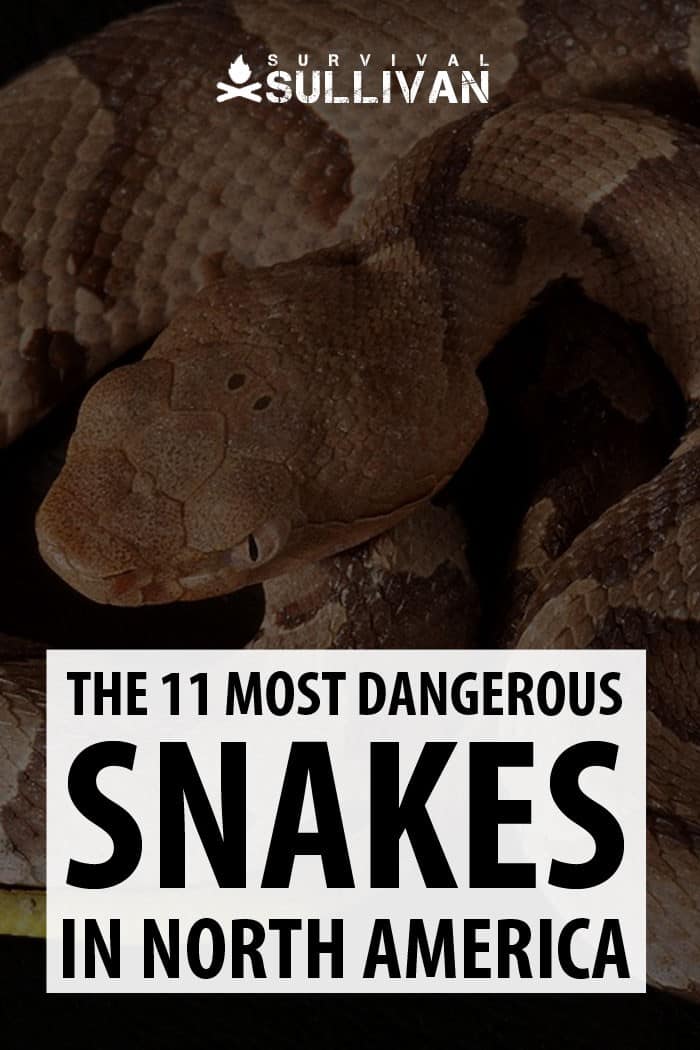

An urban prepper and rural wannabe, Karen has been working as a freelance writer for a decade and prepping for about half that time. She has gathered a wealth of knowledge on preparing for SHTF, but there is always more to learn and she has a passion for gathering and sharing that knowledge with other like-minded folk. Karen lives in London, Canada with her two children and plethora of cats.

Funny that you say that these ae the 10 most poisonous snakes. In Australia our snakes put your snakes to shame in the poisonoue department. Your 10 dont even rank in the top 10 in the world. How about some reality. You audience might find themselves in another country when SHTF.
“US Mainland” was mentioned in first section. The majority of us will be there. The author also didnot cover Hawaii or the US Territories. Reality check needed indeed.
Lois you are not too familiar with Hawaii.
It has no snakes. Absolutely 0 snakes. This is due to their large mongoose population
Your article was good on the nature and effects of various north american snakes. i only take issue with the described ranges of some of them. I grew up in Oregon where we had timber rattlers diamondbacks western cotton mouth and copperheads. I live in texas now and have seen eastern and western coral snakes copperheads and cottonmouth (which will chase a human sometimes) although i have not yet encountered a rattlesnake in texas. when i was 10 i went with a large group on a snake gather in southern california. They only caught rattle snakes. 109 in about 3 hours. the small ones were taken alive and milked for venom for years the big ones were grilled at a big after party (rattle snake tasted like someone peed on the meat to my 10 yo taste buds). when the big ones were taken their heads were removed and the venom farm guys showed us that a snake with no head will still strike at you if you touch the body.
You are certainly correct on that. Aussies have to deal with banded sea snakes, eastern taipans, and the ever-present common brown. You folks have some THE most poisonous animals on the face of the earth. The box jellyfish and that nasty spider….scary. Think I’ll stick to hiking the U.S.
Hey Bob
You said call for help , and then sit down calmly and watch the venom spread.
after shtf or a real disaster there will be no one to call.
this is a survival blog. why didn’t you cover if your on your own.
Find a nice place to lie down and kiss your butt goodbye?
We need shtf advise; not BULL
You forgot the Western Coral Snake found in Arizona and New Mexico and perhaps Western Texas and S. California.. Equally as deadly as the Eastern Coral Snake.
Dan;
I found the snake article a good bit of information, But just like all of the others I have read it says get to a hospital! In the real world or in a world that many people are prepping for that may not be possible. What we need is information about what to do when getting medical help is not a possibility. How can we do something other than wait for the victim to die or get better on its own.
Thanks for your work and time.
I’m in the woods, bugged out, I can’t get to the hospital for a snake bite because THEY AREN”T THERE ANYMORE…now what?
I can’t call for help, the cell towers haven’t had power in days. My phone died days ago also. I’m deep in the woods and have to deal with this on my own, now what?
Some of this is not just bad but really bad information. To portend that local frostbite from applying a cold pack is a greater threat than the snakebite calls into question the author’s research and qualifications.
I am a retired PA-C and treated snakebite by green vipers in Vietnam and a Copperhead and a Western Diamondback rattler bites during my career. Here are two other errors.
1. You SHOULD apply a band above the bite only tight enough to slow the superficial venom flow up an extremity and that band should be moved about every 15 minutes as the swelling ensues.
2. Next, you SHOULD apply an antibiotic ointment and clean or preferably sterile bandage, regardless of what kind of effect it has on venom is present (BTW, I can always do a sub-cuticular tap and get a tissue sample of envenomation in tissue adjacent to wound). Most ERs in snake country stock a multi-valent crotalus antivenin which attacks venom from indigenous rattlers, coppers, and moccasins BUT NOT coral snakes which is a neurotoxic venom much like cobra venom.
Just my take on the article. BTW I agree that this article presumes you can get to an ER before incapacitation or death ensues which is a false premise IMHO.
Thank you for your comment. I have notified the author of your comment and we’ll update the article should that be the case.
Dan
It looks like prevention is the name of the game here, problem is that doesn’t always work out. If we’re deep in the woods with no cell service or 911 service what are our options?
I live in Akron Ohio color how about 2 weeks ago I was walking to work now where I work I hear there is a heavy wooded area nearby and a river that runs by so it’s perfect pitch perfect. Anyway when I was walking to work it was early morning at around 8 a chance to come across a copperhead across the street we looked at each other it was like four feet away from each other and it stopped and looked at me and I looked at him and it’s probably 10 seconds and then it went on I wasn’t sure I thought maybe was a water snake but the minute but I haven’t seen a copperhead in my life until that day. It was about 2 feet long and I feel gifted in a way to have seen it and now that I know what it was I will be a little bit more cautious as I walk to work. But it was a beautiful beautiful snake and I’ve got to admit I’m working for just a stunning. At any rate your information was very very good and even though I’ve been trained in first aid snake bites is one thing if they don’t cover you don’t really delve into it. And hungry they should. I think it would have been also noteworthy to explain which poisonous snakes are poisonous from birth and which aren’t because this is critical to know as well.
If in the field when the stuff hits the fan ,you might try an old trick from always back. Wrap newspaper around your lower legs, and wear leather gloves with the same wraps from wrist to elbow! This worked back in the day! They used to have leather wraps for leg and arms, don’t know if they still sell these or not. You might look, or fashion your own.🤔😁